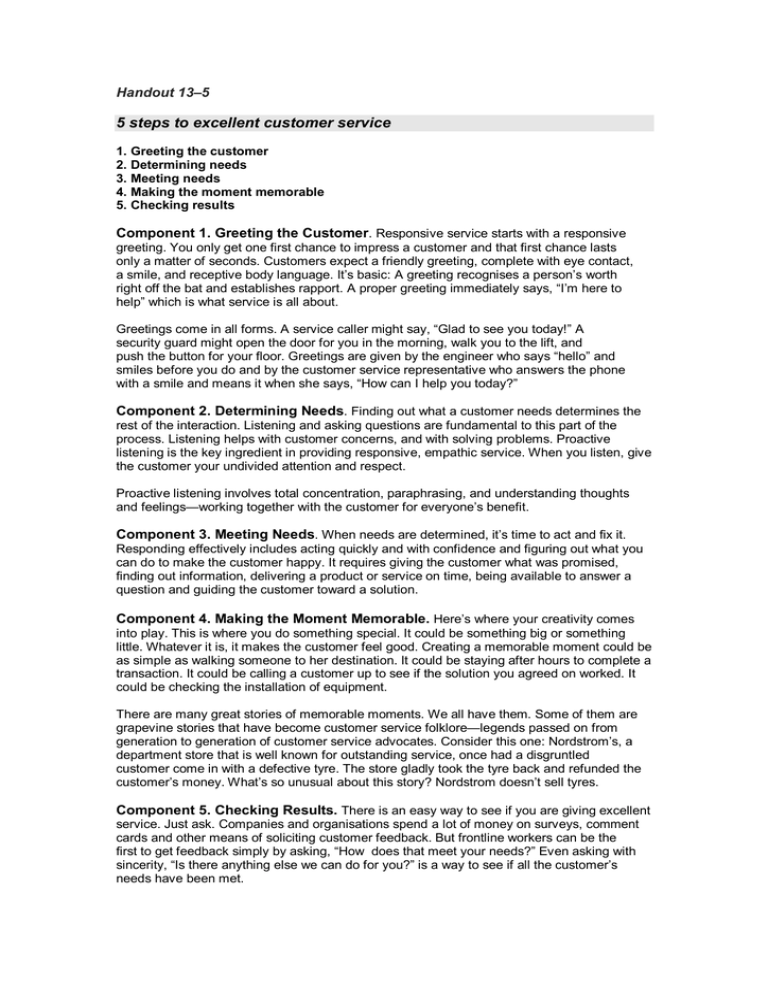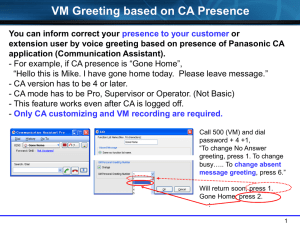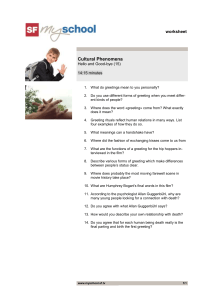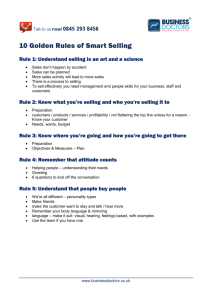5 steps to excellent customer service
advertisement

Handout 13–5 The Fantastic Service Equation 5 steps to excellent customer service 1. Greeting the customer 2. Determining needs 3. Meeting needs 4. Making the moment memorable 5. Checking results Component 1. Greeting the Customer. Responsive service starts with a responsive greeting. You only get one first chance to impress a customer and that first chance lasts only a matter of seconds. Customers expect a friendly greeting, complete with eye contact, a smile, and receptive body language. It’s basic: A greeting recognises a person’s worth right off the bat and establishes rapport. A proper greeting immediately says, “I’m here to help” which is what service is all about. Greetings come in all forms. A service caller might say, “Glad to see you today!” A security guard might open the door for you in the morning, walk you to the lift, and push the button for your floor. Greetings are given by the engineer who says “hello” and smiles before you do and by the customer service representative who answers the phone with a smile and means it when she says, “How can I help you today?” Component 2. Determining Needs. Finding out what a customer needs determines the rest of the interaction. Listening and asking questions are fundamental to this part of the process. Listening helps with customer concerns, and with solving problems. Proactive listening is the key ingredient in providing responsive, empathic service. When you listen, give the customer your undivided attention and respect. Proactive listening involves total concentration, paraphrasing, and understanding thoughts and feelings—working together with the customer for everyone’s benefit. Component 3. Meeting Needs. When needs are determined, it’s time to act and fix it. Responding effectively includes acting quickly and with confidence and figuring out what you can do to make the customer happy. It requires giving the customer what was promised, finding out information, delivering a product or service on time, being available to answer a question and guiding the customer toward a solution. Component 4. Making the Moment Memorable. Here’s where your creativity comes into play. This is where you do something special. It could be something big or something little. Whatever it is, it makes the customer feel good. Creating a memorable moment could be as simple as walking someone to her destination. It could be staying after hours to complete a transaction. It could be calling a customer up to see if the solution you agreed on worked. It could be checking the installation of equipment. There are many great stories of memorable moments. We all have them. Some of them are grapevine stories that have become customer service folklore—legends passed on from generation to generation of customer service advocates. Consider this one: Nordstrom’s, a department store that is well known for outstanding service, once had a disgruntled customer come in with a defective tyre. The store gladly took the tyre back and refunded the customer’s money. What’s so unusual about this story? Nordstrom doesn’t sell tyres. Component 5. Checking Results. There is an easy way to see if you are giving excellent service. Just ask. Companies and organisations spend a lot of money on surveys, comment cards and other means of soliciting customer feedback. But frontline workers can be the first to get feedback simply by asking, “How does that meet your needs?” Even asking with sincerity, “Is there anything else we can do for you?” is a way to see if all the customer’s needs have been met.


